Characteristics of Runoff Components in the Mingyong Glacier Basin, Meili Snow Mountains
Abstract
:1. Introduction
2. Study Area
3. Data Sources and Methods
3.1. Field Sampling
3.2. Sample Analysis
3.3. Research Method
4. Results
4.1. Variation Characteristics of Stable Isotopes for Different Water Bodies
4.2. Water Line
4.3. Hydrograph Separation of Mingyong River
5. Discussion
6. Conclusions
- (1)
- The analysis results of isotopic variations in different water bodies are as follows. In addition to the significant differences in precipitation isotopes, the isotopes variation characteristics of other waters tend to be stable. On the spatial scale, the annual average values of δD and δ18O in each water body are in the following order: precipitation, groundwater, glacial ice, river water (river downstream), ice-melt water, and river water (river midstream). The annual average values of d-excess in each water body are in the following order: ice-melt water, river water (river downstream), river water (river midstream), glacial ice, precipitation, and groundwater. The variation ranges and annual average values of δD, δ18O, and d-excess of ice-melt water, river water (river midstream), and river water (river downstream) are close to each other. The annual average values of δD and δ18O between glacial ice and groundwater are close to one another, and the annual average values of d-excess of precipitation are close to those of groundwater. In terms of time, except for glacial ice, the highest values of δD and δ18O in the other five water samples appear in spring and summer, and the lowest values appear in autumn and winter. The difference is that high and low values of δD and δ18O in glacial ice are opposite to the other water samples. In addition, the local meteoric water line of the Mingyong Glacier basin was obtained, namely LMWL: δD = 8.04δ18O + 13.06.
- (2)
- The results of hydrograph separation show that the recharge rates of ice-melt water, groundwater, and precipitation to the lower reaches of the Mingyong River in the ablation period are 80.6%, 17.2%, and 2.2%, and in the accumulation period, they are 19.2%, 73.1%, and 7.7%, respectively. At the same time, the ice-melt water in the accumulation period has a high recharge rate to groundwater, and groundwater is mostly recharged to the river water (river downstream). Therefore, ice-melt water in this area, as an important basin water resource, should be rationally planned and utilized to make an important contribution to regional sustainable development.
Author Contributions
Funding
Data Availability Statement
Acknowledgments
Conflicts of Interest
References
- Douville, H.; Raghavan, K.; Renwick, J.; Allan, R.; Arias, P.; Barlow, M.; Cerezo-Mota, R.; Cherchi, A.; Gan, T.; Gergis, J.; et al. Water cycle changes. In Climate Change 2021; Masson-Delmotte, V., Zhai, P., Pirani, A., Connors, S., Péan, C., Berger, S., Caud, N., Chen, Y., Goldfarb, L., Gomis, M., et al., Eds.; The Physical Science Basis; Cambridge University Press: Cambridge, UK, 2021. [Google Scholar]
- Lei, W.; Charles, A.L. Global climate change and its impacts. Adv. Water Sci. 2003, 14, 667–674. [Google Scholar]
- Wang, C.; Huang, M.; Zhai, P. New progress and enlightenment on different types of drought changes from IPCC Sixth Assessment Report. Acta Meteorol. Sin. 2022, 80, 168–175. [Google Scholar]
- Lu, G.; He, H. View of global hydrological cycle. Adv. Water Sci. 2006, 17, 419–424. [Google Scholar]
- Piao, S.; Ciais, P.; Huang, Y.; Shen, Z.; Peng, S.; Li, J.; Zhou, L.; Liu, H.; Ma, Y.; Ding, Y.; et al. The impacts of climate change on water resources and agriculture in China. Nature 2010, 467, 43–51. [Google Scholar] [CrossRef] [PubMed]
- Wang, X.; Huang, G.; Liu, J. Projected increases in near-surface air temperature over Ontario, Canada: A regional climate modeling approach. Clim. Dyn. 2015, 45, 1381–1393. [Google Scholar] [CrossRef]
- Vaughan, D.; Comiso, J.; Allison, I.; Carrasco, J.; Kaser, G.; Kwok, R.; Mote, P.; Murray, T.; Paul, F.; Ren, J.; et al. Observations: Cryosphere. In Climate Change 2013; Stocker, T., Qin, D., Plattner, G., Tignor, M., Allen, S., Boschung, J., Nauels, A., Xia, Y., Bex, V., Midgley, P., Eds.; The Physical Science Basis. Contribution of Working Group I to the Fifth Assessment Report of the Intergovernmental Panel on Climate Change; Cambridge University Press: Cambridge, UK, 2013. [Google Scholar]
- Oerlemans, J. Extracting a Climate Signal from 169 Glacier Records. Science 2005, 308, 675–677. [Google Scholar] [CrossRef] [PubMed]
- Yao, T.; Thompson, L.; Yang, W.; Yu, W.; Gao, Y.; Guo, X.; Yang, X.; Duan, K.; Zhao, H.; Xu, B.; et al. Different glacier status with atmospheric circulations in Tibetan Plateau and surroundings. Nat. Clim. Chang. 2012, 2, 663–667. [Google Scholar] [CrossRef]
- Kong, Y.; Pang, Z. Isotope hydrograph separation in alpine catchments: A review. J. Glaciol. Geocryol. 2010, 32, 619–625. [Google Scholar]
- Zhang, Y.; Wu, Y.; Wen, X.; Su, J. Application of environmental isotopes in water cycle. Adv. Water Sci. 2006, 17, 738–747. [Google Scholar]
- Klaus, J.; McDonnell, J. Hydrograph Separation Using Stable Isotopes: Review and Evaluation. J. Hydrol. 2013, 505, 47–64. [Google Scholar] [CrossRef]
- Zhang, G.; Jiao, Y.; He, L.; Liu, X.; Liu, C.; Yan, X.; Wang, M. Hydrogen and oxygen isotopes in precipitation in southwest China: Progress and prospects. J. Glaciol. Geocryol. 2015, 37, 1094–1103. [Google Scholar]
- Miao, W.; Liu, S.; Zhu, Y.; Duan, S.; Han, F. Spatio-temporal differentiation and altitude dependence of temperature and precipitation in Meili Snow Mountains. Clim. Chang. Res. 2022, 18, 328–342. [Google Scholar]
- Wu, K.; Liu, S.; Zhu, Y.; Xie, F.; Gao, Y. High-resolution monitoring of glacier dynamics based on unmanned aerial vehicle survey in the Meili Snow Mountain. Prog. Geogr. 2021, 40, 1581–1589. [Google Scholar] [CrossRef]
- Kong, Y.; Wang, K.; Pu, T.; Shi, X. Nonmonsoon precipitation dominates groundwater recharge beneath a monsoon-affected glacier in Tibetan Plateau. J. Geophys. Res. Atmos. 2019, 124, 10913–10930. [Google Scholar] [CrossRef]
- Shi, Y. Concise Glacier Inventory of China; Shanghai Popular Science Press: Shanghai, China, 2008. [Google Scholar]
- Lan, Y.; Liu, G.; Shao, X. Variation of the Melang Glacier in Mount Kawa Karpo in the Past 40 Years, Based on Dendrochronolog. J. Glaciol. Geocryol. 2011, 33, 1229–1234. [Google Scholar]
- Yang, Z. Biodiversity and its conservation in the scenic area of Deqin-Meili Snow Mountain, Yunnan Province. For. Inventory Plan. 2008, 33, 14–18. [Google Scholar]
- Duan, S.; Liu, S.; Zhu, Y.; Miao, W.; Han, F.; Qi, M. Reconstructing and analyzing avalanche events of 1991 and 2019 in Meili Snow Mountain. J. Glaciol. Geocryol. 2022, 44, 771–783. [Google Scholar]
- Zheng, B.; Zhao, X.; Li, T.; Wang, C. Features and fluctuation of the Melang Glacier in the Mainri Mountain. J. Glaciol. Geocryol. 1999, 21, 145–150. [Google Scholar]
- Christophersen, N.; Hooper, R. Multivariate analysis of stream water chemical data: The use of principal components analysis for the end-member mixing problem. Water Resour. Res. 1992, 28, 99–107. [Google Scholar] [CrossRef]
- Dansgaard, W. Stable isotopes in precipitation. Tellus 1964, 16, 436–468. [Google Scholar] [CrossRef]
- Friedman, I.; Machta, L.; Soller, R. Water-vapor exchange between a water droplet and its environment. J. Geophys. Res. 1962, 67, 2761–2766. [Google Scholar] [CrossRef]
- Du, J.; He, Y.; Li, S.; Wang, S.; Niu, H. Mass balance of a typical monsoonal temperate glacier in Hengduan Mountains Region. Acta Geogr. Sin. 2015, 70, 1415–1422. [Google Scholar]


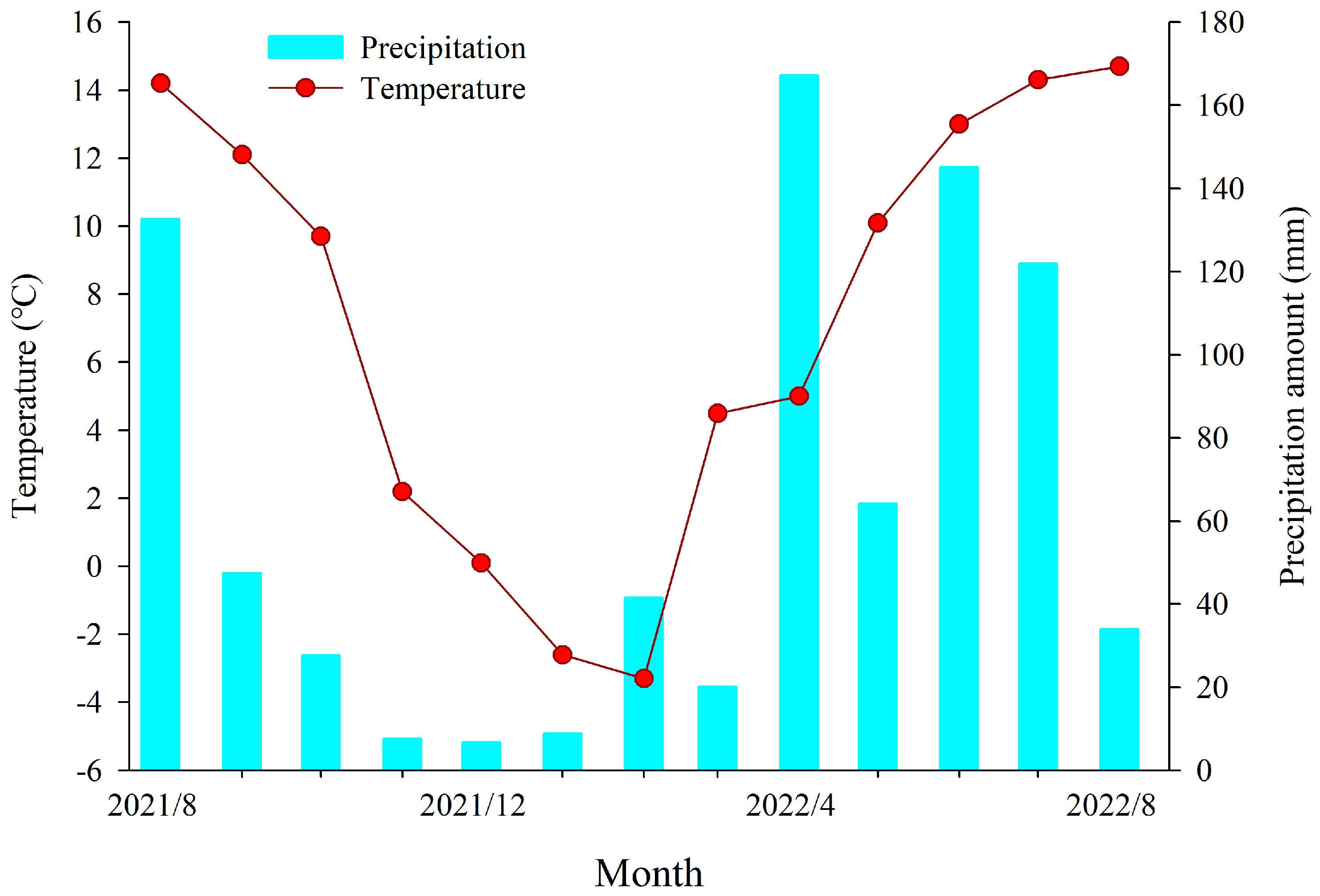
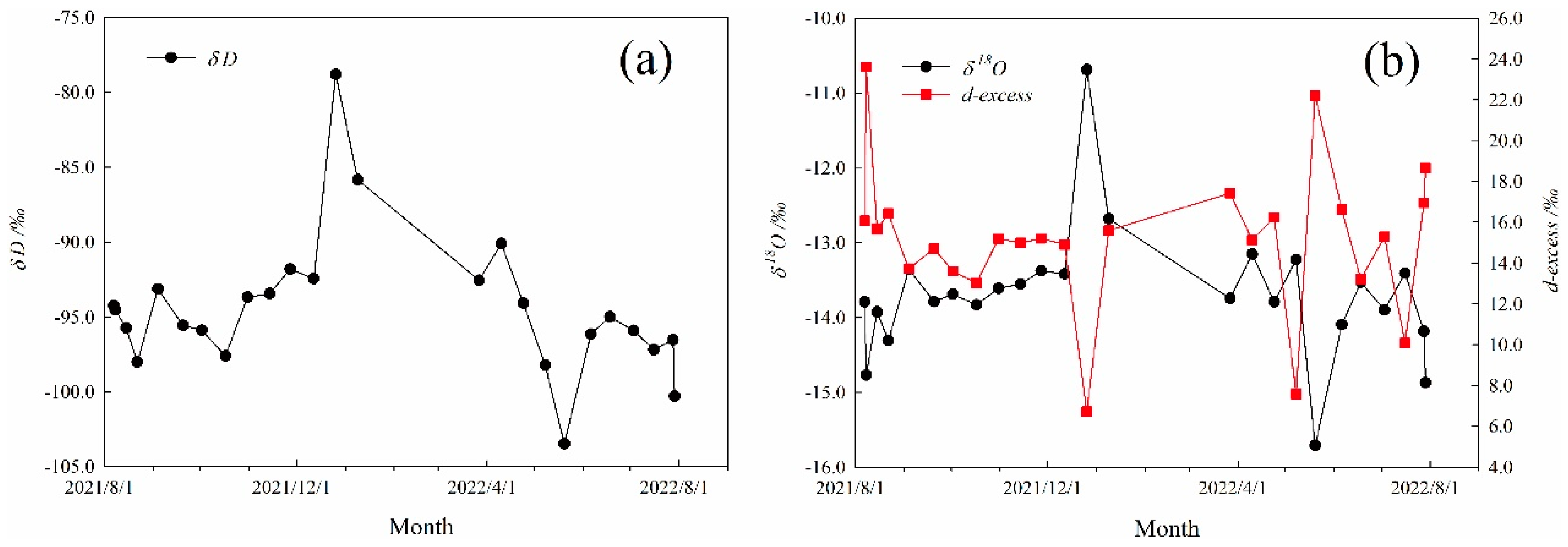

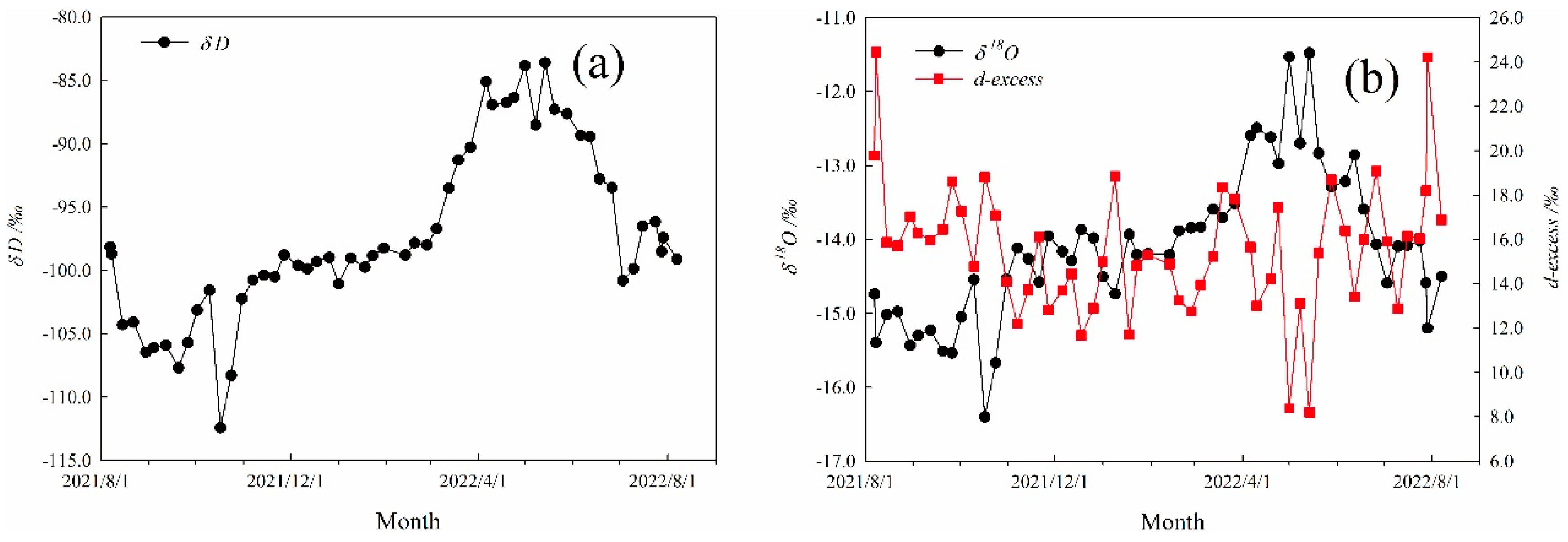
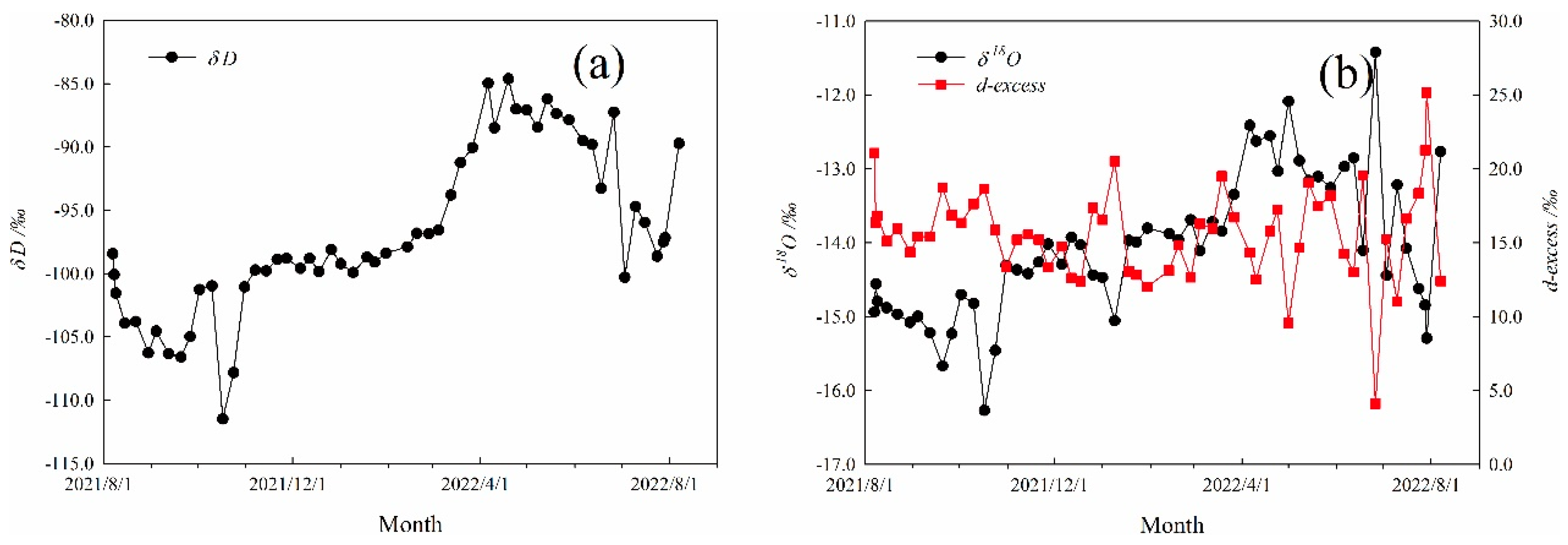

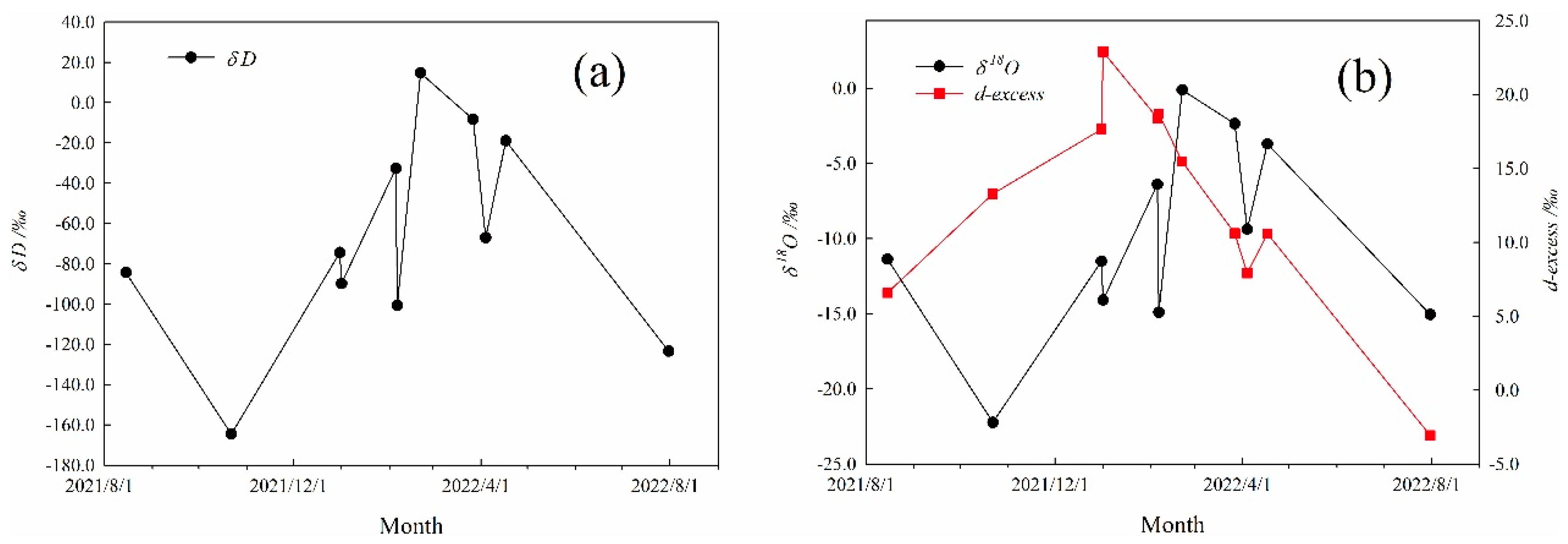



| Glacial Ice (n=25) | Ice-Melt (n = 45) | River Midstream (n = 54) | River Downstream (n = 55) | Spring (n = 54) | Precipitation (n = 11) | ||||||||||||||||
|---|---|---|---|---|---|---|---|---|---|---|---|---|---|---|---|---|---|---|---|---|---|
| Month | T (°C) | P (mm) | RH (%) | δ18O (‰) | δD (‰) | d-Excess (‰) | δ18O (‰) | δD (‰) | d-Excess (‰) | δ18O (‰) | δD (‰) | d-Excess (‰) | δ18O (‰) | δD (‰) | d-Excess (‰) | δ18O (‰) | δD (‰) | d-Excess (‰) | δ18O (‰) | δD (‰) | d-Excess (‰) |
| Aug. 2021 | 14.20 | 132.60 | 80.50 | −14.20 | −95.64 | 17.96 | −15.20 | −102.92 | 18.68 | −15.11 | −102.33 | 18.55 | −14.87 | −102.34 | 16.62 | −13.66 | −93.78 | 15.50 | −11.37 | −84.36 | 6.60 |
| Sep. 2021 | 12.10 | 47.40 | 77.80 | −13.57 | −94.35 | 14.21 | −15.51 | −106.34 | 17.74 | −15.40 | −106.34 | 16.86 | −15.28 | −105.61 | 16.63 | −13.33 | −94.28 | 12.36 | |||
| Oct. 2021 | 9.70 | 27.60 | 73.30 | −13.71 | −95.73 | 13.95 | −15.43 | −106.43 | 17.01 | −15.24 | −105.52 | 16.40 | −15.11 | −104.52 | 16.36 | −13.28 | −93.36 | 12.88 | −22.23 | −164.55 | 13.29 |
| Nov. 2021 | 2.20 | 7.50 | 63.80 | −13.46 | −92.62 | 15.06 | −14.08 | −99.49 | 13.15 | −14.23 | −100.10 | 13.74 | −14.27 | −99.29 | 14.87 | −13.13 | −92.84 | 12.20 | |||
| Dec. 2021 | 0.10 | 6.70 | 60.60 | −12.05 | −85.61 | 10.79 | −13.21 | −94.18 | 11.50 | −14.08 | −99.43 | 13.21 | −14.17 | −99.09 | 14.27 | −13.11 | −93.26 | 11.62 | −11.52 | −74.48 | 17.68 |
| Jan. 2022 | −2.60 | 8.80 | 62.50 | −12.68 | −85.83 | 15.61 | −13.63 | −92.95 | 16.09 | −14.31 | −99.38 | 15.10 | −14.26 | −99.07 | 15.01 | −13.34 | −93.65 | 13.07 | −14.09 | −89.80 | 22.92 |
| Feb. 2022 | −3.30 | 41.50 | 66.30 | −13.98 | −98.19 | 13.65 | −13.84 | −97.19 | 13.53 | −13.04 | −92.64 | 11.68 | −7.14 | −39.57 | 17.55 | ||||||
| Mar. 2022 | 4.50 | 20.10 | 58.80 | −13.75 | −92.55 | 17.45 | −12.66 | −86.72 | 14.56 | −13.66 | −92.95 | 16.33 | −13.75 | −92.91 | 17.09 | −13.24 | −92.30 | 13.62 | −2.36 | −8.26 | 10.62 |
| Apr. 2022 | 5.00 | 167.10 | 79.00 | −13.47 | −92.09 | 15.67 | −12.72 | −87.07 | 14.69 | −12.67 | −86.28 | 15.08 | −12.65 | −86.27 | 14.93 | −12.67 | −88.39 | 12.97 | −6.54 | −43.03 | 9.29 |
| May 2022 | 10.10 | 64.10 | 74.80 | −14.47 | −100.85 | 14.91 | −12.84 | −87.28 | 15.44 | −12.37 | −86.17 | 12.79 | −12.90 | −87.40 | 15.80 | −12.79 | −89.48 | 12.84 | |||
| Jun. 2022 | 13.00 | 145.00 | 79.30 | −13.81 | −95.57 | 14.91 | −13.68 | −92.31 | 17.13 | −13.43 | −91.26 | 16.18 | −12.84 | −89.96 | 12.76 | −12.48 | −88.91 | 10.93 | |||
| Jul. 2022 | 14.30 | 121.80 | 74.30 | −14.09 | −97.48 | 15.24 | −14.38 | −98.75 | 16.29 | −14.43 | −98.21 | 17.23 | −14.41 | −97.37 | 17.91 | −11.93 | −87.30 | 8.14 | −15.04 | −123.41 | −3.09 |
Disclaimer/Publisher’s Note: The statements, opinions and data contained in all publications are solely those of the individual author(s) and contributor(s) and not of MDPI and/or the editor(s). MDPI and/or the editor(s) disclaim responsibility for any injury to people or property resulting from any ideas, methods, instructions or products referred to in the content. |
© 2024 by the authors. Licensee MDPI, Basel, Switzerland. This article is an open access article distributed under the terms and conditions of the Creative Commons Attribution (CC BY) license (https://creativecommons.org/licenses/by/4.0/).
Share and Cite
Zhang, Z.; Wu, L.; Feng, J.; Dong, Z.; Zhao, X.; Sun, Y.; Cheng, X.; Dong, L.; Liu, T. Characteristics of Runoff Components in the Mingyong Glacier Basin, Meili Snow Mountains. Water 2024, 16, 937. https://doi.org/10.3390/w16070937
Zhang Z, Wu L, Feng J, Dong Z, Zhao X, Sun Y, Cheng X, Dong L, Liu T. Characteristics of Runoff Components in the Mingyong Glacier Basin, Meili Snow Mountains. Water. 2024; 16(7):937. https://doi.org/10.3390/w16070937
Chicago/Turabian StyleZhang, Zichen, Lihua Wu, Jun Feng, Zhiwen Dong, Xiong Zhao, Yi Sun, Xiping Cheng, Liqin Dong, and Tingting Liu. 2024. "Characteristics of Runoff Components in the Mingyong Glacier Basin, Meili Snow Mountains" Water 16, no. 7: 937. https://doi.org/10.3390/w16070937





